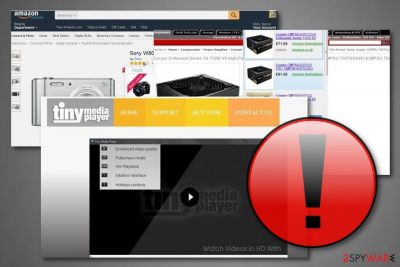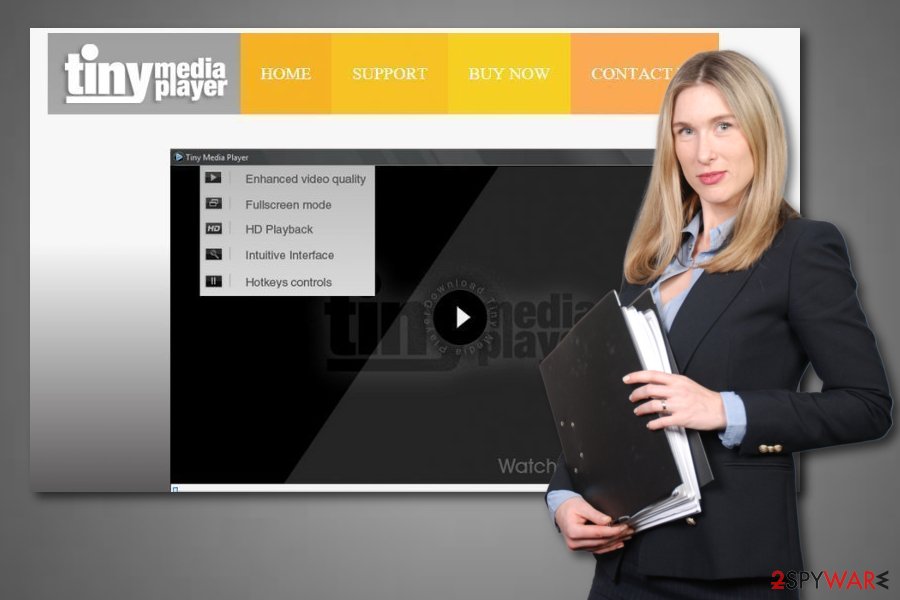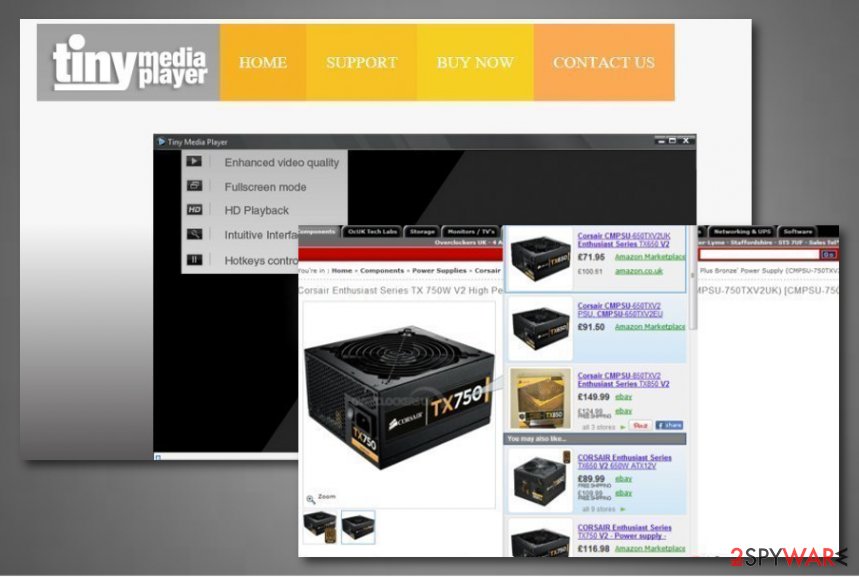Tiny Media Player adware (Removal Guide) - updated Sep 2019
Tiny Media Player adware Removal Guide
What is Tiny Media Player adware?
Tiny Media Player – an advertising network that might push bogus deals of particular products or services

Tiny Media Player, also known as Ads by Tiny Media Player, is a potentially unwanted program (PUP) or adware,[1] which may flood you with an excessive amount of advertisements, may spy on you, diminish your web browser's performance and initiated other unwanted activities. Therefore, no matter that its developers are trying to convince you that this tool is the one that allows playing music, watching video, making playlists, open various diverse file formats (mp3, ogg, wav, wma, cda, mpg, wmv, vcd, svcd, dvd), and provide you with other useful services related to media playing, you should be aware that it may initiate various marketing campaigns behind your back. We cannot claim that like a media player Tiny Media Player will be useless. However, we can ensure you that it will be irritating, disruptive, and risk-posing.
| Name | Tiny Media Player |
|---|---|
| Also known as | Ads by Tiny Media Player |
| Type | Adware application |
| Sub-type | Potentially unwanted program |
| Related files | If you have been affected by the adware program, it might bring addition files to your computer: Tiny Media Player.exe, Tiny Media Player-bg.exe, Tiny Media Player-bho64.dll, Tiny Media Player-nova.exe |
| Activities | Hijacking web browser applications and modifying their homepages, redirecting the user to affiliate networks, providing a big load of annoying adverts |
| Deletion | You can use FortectIntego that will lengthen the entire removal process. Scan the system with this software, detect all infectious sources and eliminate all of them automatically/manually. All instructions are added to the end of this article |
Tiny Media Player typically spreads bundled with various freeware/shareware.[2] This way, it may enter computers without being noticed. Once installed, it may hijack web browsers, including Google Chrome, Mozilla Firefox, Internet Explorer, Safari, and start displaying tons of sponsored advertisements on each of them.
Additionally, Tiny Media Player virus might bring bogus components, files, and processes to the targeted computer system. We have made a wide research and discovered that this adware program is capable of injecting these components:
- Tiny Media Player.exe;
- Tiny Media Player-bg.exe;
- Tiny Media Player-bho64.dll;
- Tiny Media Player-nova.exe.
Unfortunately, but Tiny Media Player ads tend to appear in such irritating forms as pop-ups, pop-unders, banners, interstitials, and so on, which means that their emergence will certainly disrupt your browsing sessions. However, an attempt to promote third parties, their websites, merchandise, and software is not only annoying.

“Ads by Tiny Media Player”, “Tiny Media Player Ads”, “Powered by Tiny Media Player” and similarly marked advertisements may disguise links to suspicious websites, so you should avoid clicking on them. Moreover, this adware is blamed for collecting user's search terms, mostly visited websites, clicks, IP address, PC's location, email address, clicks, and similar personally non-identifiable information.
After Tiny Media Player gathers all the details mentioned above, the program developers are able to generate beneficial-looking adverts regarding the user's needs. However, these offers usually appear to be misleading and suggest to purchase a bogus-looking product or service as income-collecting is the primary task of adware spreaders.
Therefore, if you want to prevent Tiny Media Player redirects from happening, data from leakage, the browser's from slowdowns, and similar issues, you should check your computer with a reputable anti-spyware and remove it without a delay using FortectIntego or another reputable anti-malware.
Besides, you can perform the Tiny Media Player removal with the help of manual instructing guidelines if you believe in yourself as in a fully-experienced computer user. Below you will discover instructions for your Windows OS and web browsers such as Google Chrome, Mozilla Firefox, Internet Explorer, Safari, and Microsoft Edge.
Note that you need to remove Tiny Media Player fully, otherwise, your web browsers might still remain infected. Adware-based programs are very likely to include questionable extensions and add-ons to the browser's settings which allow the program to boot up automatically within every browser launching.

Hijacks happen after bogus software is installed under the user's consent
According to security experts from LesVirus.fr,[3] potentially unwanted programs, including adware-supported applications, spread bundled with various freeware and shareware as an 'optional component'. Although such distribution method is not abandoned, it's considered as unfair and is mainly used by unfair parties who seek to spread 'unfair' add-ons, plug-ins, toolbars, and extensions.
Therefore, no matter that you have downloaded freeware from a reliable download source like, for instance, Cnet, Softonic, Soft32, Download, etc., we recommend selecting Advanced/Custom installation option and monitoring the entire installation process as this will guarantee you much more safety.
Keep in mind that third-party apps may be disclosed in a very misleading manner, so draw your attention on each notification that is provided on the installation wizard. Otherwise, you may skip the list of 'optional downloads' unnoticed and allow it to be installed by default. Right after that, you may start experiencing Tiny Media Player redirects, slowdowns, and other inconveniences.
Removing Tiny Media Player virus with the help of automatical/manual guidelines
If you suspect that this potential threat is lurking on your computer's system, take corresponding actions and get rid of it without a delay from your Windows operating system and web browser application. In order to remove Tiny Media Player virus, you may use automatical or manual instructing steps. Below you will find both guidelines that will help you throughout the entire process.
We recommend choosing the automatical Tiny Media Player removal option if you are a less-experienced user in the cyber threat elimination field. Besides, by employing reliable antimalware, you will use less of your time and prevent yourself from making damaging mistakes. However, if you believe to have enough skills in the cybersecurity sphere, use these below-provided instructing lines and learn how to clean your computer/browsers manually.
You may remove virus damage with a help of FortectIntego. SpyHunter 5Combo Cleaner and Malwarebytes are recommended to detect potentially unwanted programs and viruses with all their files and registry entries that are related to them.
Getting rid of Tiny Media Player adware. Follow these steps
Uninstall from Windows
Eliminate all bogus products from your Windows computer system. Use these steps to achieve such task:
Instructions for Windows 10/8 machines:
- Enter Control Panel into Windows search box and hit Enter or click on the search result.
- Under Programs, select Uninstall a program.

- From the list, find the entry of the suspicious program.
- Right-click on the application and select Uninstall.
- If User Account Control shows up, click Yes.
- Wait till uninstallation process is complete and click OK.

If you are Windows 7/XP user, proceed with the following instructions:
- Click on Windows Start > Control Panel located on the right pane (if you are Windows XP user, click on Add/Remove Programs).
- In Control Panel, select Programs > Uninstall a program.

- Pick the unwanted application by clicking on it once.
- At the top, click Uninstall/Change.
- In the confirmation prompt, pick Yes.
- Click OK once the removal process is finished.
Remove from Microsoft Edge
Delete unwanted extensions from MS Edge:
- Select Menu (three horizontal dots at the top-right of the browser window) and pick Extensions.
- From the list, pick the extension and click on the Gear icon.
- Click on Uninstall at the bottom.

Clear cookies and other browser data:
- Click on the Menu (three horizontal dots at the top-right of the browser window) and select Privacy & security.
- Under Clear browsing data, pick Choose what to clear.
- Select everything (apart from passwords, although you might want to include Media licenses as well, if applicable) and click on Clear.

Restore new tab and homepage settings:
- Click the menu icon and choose Settings.
- Then find On startup section.
- Click Disable if you found any suspicious domain.
Reset MS Edge if the above steps did not work:
- Press on Ctrl + Shift + Esc to open Task Manager.
- Click on More details arrow at the bottom of the window.
- Select Details tab.
- Now scroll down and locate every entry with Microsoft Edge name in it. Right-click on each of them and select End Task to stop MS Edge from running.

If this solution failed to help you, you need to use an advanced Edge reset method. Note that you need to backup your data before proceeding.
- Find the following folder on your computer: C:\\Users\\%username%\\AppData\\Local\\Packages\\Microsoft.MicrosoftEdge_8wekyb3d8bbwe.
- Press Ctrl + A on your keyboard to select all folders.
- Right-click on them and pick Delete

- Now right-click on the Start button and pick Windows PowerShell (Admin).
- When the new window opens, copy and paste the following command, and then press Enter:
Get-AppXPackage -AllUsers -Name Microsoft.MicrosoftEdge | Foreach {Add-AppxPackage -DisableDevelopmentMode -Register “$($_.InstallLocation)\\AppXManifest.xml” -Verbose

Instructions for Chromium-based Edge
Delete extensions from MS Edge (Chromium):
- Open Edge and click select Settings > Extensions.
- Delete unwanted extensions by clicking Remove.

Clear cache and site data:
- Click on Menu and go to Settings.
- Select Privacy, search and services.
- Under Clear browsing data, pick Choose what to clear.
- Under Time range, pick All time.
- Select Clear now.

Reset Chromium-based MS Edge:
- Click on Menu and select Settings.
- On the left side, pick Reset settings.
- Select Restore settings to their default values.
- Confirm with Reset.

Remove from Mozilla Firefox (FF)
You can free Mozilla Firefox from questionable software and reverse all dubious changes by performing these guidelines:
Remove dangerous extensions:
- Open Mozilla Firefox browser and click on the Menu (three horizontal lines at the top-right of the window).
- Select Add-ons.
- In here, select unwanted plugin and click Remove.

Reset the homepage:
- Click three horizontal lines at the top right corner to open the menu.
- Choose Options.
- Under Home options, enter your preferred site that will open every time you newly open the Mozilla Firefox.
Clear cookies and site data:
- Click Menu and pick Settings.
- Go to Privacy & Security section.
- Scroll down to locate Cookies and Site Data.
- Click on Clear Data…
- Select Cookies and Site Data, as well as Cached Web Content and press Clear.

Reset Mozilla Firefox
If clearing the browser as explained above did not help, reset Mozilla Firefox:
- Open Mozilla Firefox browser and click the Menu.
- Go to Help and then choose Troubleshooting Information.

- Under Give Firefox a tune up section, click on Refresh Firefox…
- Once the pop-up shows up, confirm the action by pressing on Refresh Firefox.

Remove from Google Chrome
Clean your Google Chrome web browser with the help of the below-given steps:
Delete malicious extensions from Google Chrome:
- Open Google Chrome, click on the Menu (three vertical dots at the top-right corner) and select More tools > Extensions.
- In the newly opened window, you will see all the installed extensions. Uninstall all the suspicious plugins that might be related to the unwanted program by clicking Remove.

Clear cache and web data from Chrome:
- Click on Menu and pick Settings.
- Under Privacy and security, select Clear browsing data.
- Select Browsing history, Cookies and other site data, as well as Cached images and files.
- Click Clear data.

Change your homepage:
- Click menu and choose Settings.
- Look for a suspicious site in the On startup section.
- Click on Open a specific or set of pages and click on three dots to find the Remove option.
Reset Google Chrome:
If the previous methods did not help you, reset Google Chrome to eliminate all the unwanted components:
- Click on Menu and select Settings.
- In the Settings, scroll down and click Advanced.
- Scroll down and locate Reset and clean up section.
- Now click Restore settings to their original defaults.
- Confirm with Reset settings.

Delete from Safari
Remove unwanted extensions from Safari:
- Click Safari > Preferences…
- In the new window, pick Extensions.
- Select the unwanted extension and select Uninstall.

Clear cookies and other website data from Safari:
- Click Safari > Clear History…
- From the drop-down menu under Clear, pick all history.
- Confirm with Clear History.

Reset Safari if the above-mentioned steps did not help you:
- Click Safari > Preferences…
- Go to Advanced tab.
- Tick the Show Develop menu in menu bar.
- From the menu bar, click Develop, and then select Empty Caches.

After uninstalling this potentially unwanted program (PUP) and fixing each of your web browsers, we recommend you to scan your PC system with a reputable anti-spyware. This will help you to get rid of Tiny Media Player registry traces and will also identify related parasites or possible malware infections on your computer. For that you can use our top-rated malware remover: FortectIntego, SpyHunter 5Combo Cleaner or Malwarebytes.
How to prevent from getting adware
Stream videos without limitations, no matter where you are
There are multiple parties that could find out almost anything about you by checking your online activity. While this is highly unlikely, advertisers and tech companies are constantly tracking you online. The first step to privacy should be a secure browser that focuses on tracker reduction to a minimum.
Even if you employ a secure browser, you will not be able to access websites that are restricted due to local government laws or other reasons. In other words, you may not be able to stream Disney+ or US-based Netflix in some countries. To bypass these restrictions, you can employ a powerful Private Internet Access VPN, which provides dedicated servers for torrenting and streaming, not slowing you down in the process.
Data backups are important – recover your lost files
Ransomware is one of the biggest threats to personal data. Once it is executed on a machine, it launches a sophisticated encryption algorithm that locks all your files, although it does not destroy them. The most common misconception is that anti-malware software can return files to their previous states. This is not true, however, and data remains locked after the malicious payload is deleted.
While regular data backups are the only secure method to recover your files after a ransomware attack, tools such as Data Recovery Pro can also be effective and restore at least some of your lost data.





















